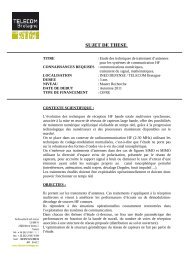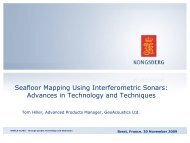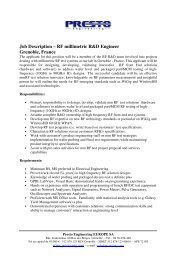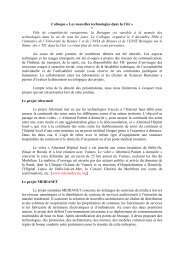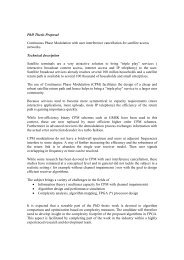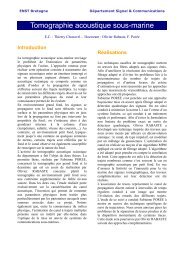Département Réseau, Sécurité et Multimédia Rapport d'Activités 2008
Département Réseau, Sécurité et Multimédia Rapport d'Activités 2008
Département Réseau, Sécurité et Multimédia Rapport d'Activités 2008
Create successful ePaper yourself
Turn your PDF publications into a flip-book with our unique Google optimized e-Paper software.
ecause it offers a generic framework overIPv6 that can be easily deployed.In 2007, we focus on mobility impacts on theSHIM6 operations. SHIM6 is a protocoldesigned to support multihoming. However,we envision that most nodes in the Intern<strong>et</strong>will be mobile, therefore we analyze the SHIM6operation in mobile environment.On one hand, we may consider to associateSHIM6 with a mobility protocol, such as MobileIP. However, such a combination mightintroduce an important overhead in terms ofconception and implementation (two abstractlayers in the IP layer) and in terms ofoverhead since a pack<strong>et</strong> may be encapsulatedseveral times. Therefore, we propose in [2] thestudy of SHIM6 operation on a mobile node.We conclude that with a proper use of UpdateRequest and Update Acknowledgementmessages, a SHIM6 context can be updatedwith new IPv6 addresses that are acquiredwhile the node is on the move. The mainconcern of such a usage is the handoverlatency. The new n<strong>et</strong>work discovery seems tobe the major part of the handover process,and we find out that IPv6 optimizations forrouter and prefix discovery that were designedto enhanced mobility protocols can be usedwith SHIM6 as well.References[1] Geoff Huston, Multi-Homing and Identity inIPv6, Intern<strong>et</strong> Soci<strong>et</strong>y Publications, June 2004[2] Amine Dhraief, Nicolas Montavont, TowardMobility and Multihoming Unification: theSHIM6 protocol : a case study, IEEE WirelessCommunications and N<strong>et</strong>working Conference(WCNC <strong>2008</strong>), March 31 - Avril 3 <strong>2008</strong>, LasVegas, USAThe experimentations we performed gave usnew perspective and highlighted someadditional issues. In a multihomedenvironment, when a mobile node acquires anew address, we need a decision algorithmthat indicates wh<strong>et</strong>her the new address mustbe used or not. We are currently investigatingthis decision algorithm.ConclusionWith the large amout of n<strong>et</strong>work protocols thathave recently been proposed, it is important toevaluate the features and the overheadintroduced by each of them. While we envisionthat in a near future most nodes will be mobileand multihomed, we need to support bothmechanisms. Instead of putting tog<strong>et</strong>herseveral protocols, we showed that SHIM6 maybe used for both mobility and multihomingsupport. Now, we still need to d<strong>et</strong>ermine theoverhead of this protocol compared to others,and we also need to adjust some param<strong>et</strong>ersof the SHIM6 protocol, such as the decisionalgorithm or the movement d<strong>et</strong>ectionmechanism.28 Extract of Pracom’s Annual Report <strong>2008</strong>




